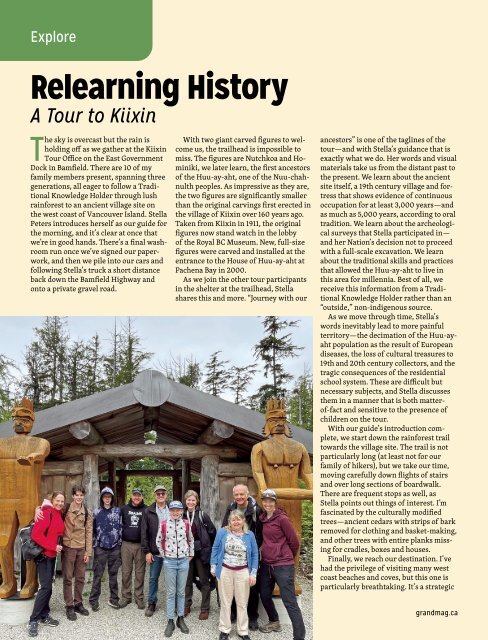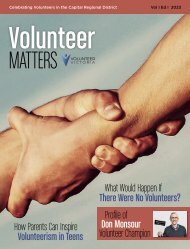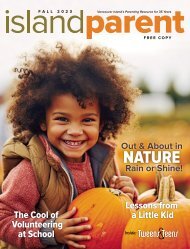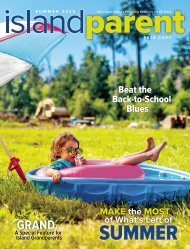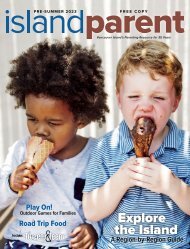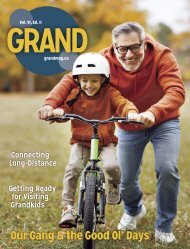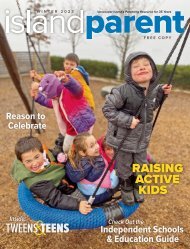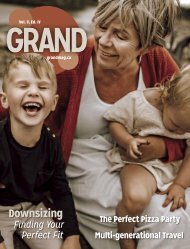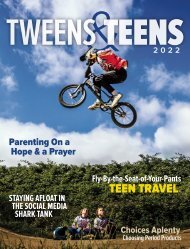GRAND Vol VI, Ed III
GRAND honours and supports grandparents by providing information on resources and businesses for families and a forum for the exchange of ideas and opinions: Relearning History: A Tour to Kiixin • Summertime Is Grandparent Time • Helping Kids Face Their Fears
GRAND honours and supports grandparents by providing information on resources and businesses for families and a forum for the exchange of ideas and opinions: Relearning History: A Tour to Kiixin • Summertime Is Grandparent Time • Helping Kids Face Their Fears
Create successful ePaper yourself
Turn your PDF publications into a flip-book with our unique Google optimized e-Paper software.
Explore<br />
Relearning History<br />
A Tour to Kiixin<br />
The sky is overcast but the rain is<br />
holding off as we gather at the Kiixin<br />
Tour Office on the East Government<br />
Dock in Bamfield. There are 10 of my<br />
family members present, spanning three<br />
generations, all eager to follow a Traditional<br />
Knowledge Holder through lush<br />
rainforest to an ancient village site on<br />
the west coast of Vancouver Island. Stella<br />
Peters introduces herself as our guide for<br />
the morning, and it’s clear at once that<br />
we’re in good hands. There’s a final washroom<br />
run once we’ve signed our paperwork,<br />
and then we pile into our cars and<br />
following Stella’s truck a short distance<br />
back down the Bamfield Highway and<br />
onto a private gravel road.<br />
With two giant carved figures to welcome<br />
us, the trailhead is impossible to<br />
miss. The figures are Nutchkoa and Hominiki,<br />
we later learn, the first ancestors<br />
of the Huu-ay-aht, one of the Nuu-chahnulth<br />
peoples. As impressive as they are,<br />
the two figures are significantly smaller<br />
than the original carvings first erected in<br />
the village of Kiixin over 160 years ago.<br />
Taken from Kiixin in 1911, the original<br />
figures now stand watch in the lobby<br />
of the Royal BC Museum. New, full-size<br />
figures were carved and installed at the<br />
entrance to the House of Huu-ay-aht at<br />
Pachena Bay in 2000.<br />
As we join the other tour participants<br />
in the shelter at the trailhead, Stella<br />
shares this and more. “Journey with our<br />
ancestors” is one of the taglines of the<br />
tour—and with Stella’s guidance that is<br />
exactly what we do. Her words and visual<br />
materials take us from the distant past to<br />
the present. We learn about the ancient<br />
site itself, a 19th century village and fortress<br />
that shows evidence of continuous<br />
occupation for at least 3,000 years—and<br />
as much as 5,000 years, according to oral<br />
tradition. We learn about the archeological<br />
surveys that Stella participated in—<br />
and her Nation’s decision not to proceed<br />
with a full-scale excavation. We learn<br />
about the traditional skills and practices<br />
that allowed the Huu-ay-aht to live in<br />
this area for millennia. Best of all, we<br />
receive this information from a Traditional<br />
Knowledge Holder rather than an<br />
“outside,” non-indigenous source.<br />
As we move through time, Stella’s<br />
words inevitably lead to more painful<br />
territory—the decimation of the Huu-ayaht<br />
population as the result of European<br />
diseases, the loss of cultural treasures to<br />
19th and 20th century collectors, and the<br />
tragic consequences of the residential<br />
school system. These are difficult but<br />
necessary subjects, and Stella discusses<br />
them in a manner that is both matterof-fact<br />
and sensitive to the presence of<br />
children on the tour.<br />
With our guide’s introduction complete,<br />
we start down the rainforest trail<br />
towards the village site. The trail is not<br />
particularly long (at least not for our<br />
family of hikers), but we take our time,<br />
moving carefully down flights of stairs<br />
and over long sections of boardwalk.<br />
There are frequent stops as well, as<br />
Stella points out things of interest. I’m<br />
fascinated by the culturally modified<br />
trees—ancient cedars with strips of bark<br />
removed for clothing and basket-making,<br />
and other trees with entire planks missing<br />
for cradles, boxes and houses.<br />
Finally, we reach our destination. I’ve<br />
had the privilege of visiting many west<br />
coast beaches and coves, but this one is<br />
particularly breathtaking. It’s a strategic<br />
grandmag.ca


